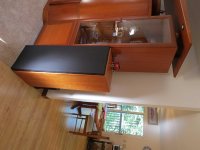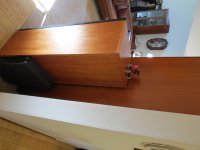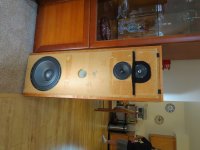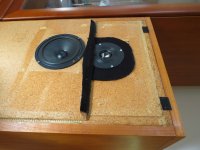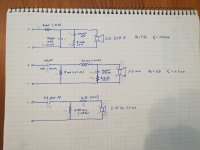This is my first time posting here, but I started building speakers in 1987. I was an active DIY builder/designer until 2002, but then moved on to other interests. My career as an engineer did not leave a lot of time for speaker building… Now I am back. Hi!
My first build in 1987 was a Madisound kit using a Peerless 8” woofer and an Audax 1” dome in a 32 liter vented box, with a pre-assembled crossover at about 3kHz. My cousin and I built the box from ¾ birch plywood, and he used it for almost 20 years.
First Scratch Build
While in engineering school, I started to design my first “from scratch” build. I had a lot of time (but no money), so I spent time reading the original A.N. Thiele and Richard Small JAES papers, Olsen, Martin Colloms’ “High Performance Loudspeakers (1st edition), Vance Dickenson “Loudspeaker Design Cookbook”, and any other research available in the University library.
After graduating in 1989, my finances greatly improved. I subscribed to Speaker Builder Magazine. Before the internet and discussion forums, Speaker Builder was best and only source of current information. I bought a Joe D’Appolito MiteyMike kit (a precision microphone, some assembly required). I wrote a Fortran program to do closed-box and vented box simulation. I bought a cross-over simulation program called “LMP” and used this to do preliminary simulations of various drivers. The simulator assumed you would be using a Zobel network to flatten the driver impedance, and that you were using drivers which were smooth and flat in their operating range. LMP was very time consuming but this was a huge leap forward from doing circuit analysis by hand.
In 1992 I was ready to begin. Despite all the advice that a first design should be a 2-way, I really wanted a 3 way. I greatly admired the PSB Stratus Gold (unaffordable) and the B&W 801 (outrageously unaffordable), and I wanted to emulate these very fine speakers. I used a Carbonneau CG-308R 12” polycone woofer, a Vifa P13WH-00 5” mineral-filled polycone driver for midrange, and a Vifa D25AG-35-06 aluminum dome tweeter. Crossover frequencies would be at 250 Hz and 3 kHz. I built the 85 liter box from ¾ inch particle board inner wall covered with ¾ inch cherry veneer plywood outer wall, with a layer of latex adhesive between the two materials. The front baffle is 2 layers of ¾ in particle board, and it has a chamfered step between the midrange and the tweeter to move the tweeter back by ¾ inch. The vented box has a 3” PVC vent, tuned to 22 Hz. The alignment is an over-damped low Q with little group delay above 35 Hz. I went overboard on internal bracing.
After installing the drivers, I used the MiteyMike to measure the raw response of the drivers and loaded this information into the LMP crossover simulator. I then designed the crossover network. I could not measure the impedance (other than Rsc) or any of the Thiele-Small parameters, I simply trusted the published values.
Measuring Response in the Old Days
Back in 1992, making a frequency response curve was no easy task in a DIY situation but at least it was possible. There were test CDs which had 1/3 octave warble tones and 1/3 octave filtered pink noise. The MiteyMike was an accurate near-lab-grade microphone which could be attached to a camera tripod. I bought a true-RMS volt meter used in the telecom industry with a response from 10 hz to 100 kHz.
To make a response curve, I would start with 20 Hz, play the appropriate test CD track, set the pre-amp volume control to 2 V, and record the voltage generated by the microphone. By “record” I mean with a pencil, on real paper. Without touching the volume control, repeat the process for the next track at 25 Hz. Then at 32 Hz. Repeat 28 more times. I was fortunate enough to have access to a PC, so I loaded the recorded voltages into Excel, converted them to dB, and plotted them… if you did not have access to a PC or Mac, you did the calcs with a calculator and plotted by hand on log-linear graph paper. Having completed the on-axis measurements, I moved the microphone to the 30 degree off-axis position and repeated. Repeated again for 45 degree off axis. Repeat again for vertical dispersion… Etc. etc. etc.… It took hours to fully measure the response of one driver.
I also made near-field measurements of the woofer and midrange, and these were spliced onto the far-field measurements… it took some judgement to make the splice, and looking back at my notes I think I used 200 Hz as the splice point.
Result
After two tweaks to the cross-over, the final on-axis measured response in my living room was within +/- 2.5 dB from 80 Hz to 16 kHz. Above 16k the tweeter tapers off a bit. Bass is clean and tight down to 25 Hz. My living room is very large at 22’ x 32’ with a vaulted ceiling that varies from 8’ to 21’ high, so room gain doesn’t really start until 40 Hz or so.
The lower crossover at 250 Hz is electrically 2nd order, and acoustically it is quasi-3rd order. I had to tweak the crossover twice to get it acceptable. The upper crossover at 3 kHz is electrically 1st order on the mid, and 2nd order on the tweeter. Acoustically it is quasi 3rd order. The upper crossover was perfect from the start.
Because I designed the filters after the cabinet was built, I mounted the crossover externally in a box on the cabinet rear, covered in black felt.
I have used these speakers continuously since 1993. Clarity and tonal balance are spot on. Great detail, high SPL capability, very rhythmic bass. Piano, human voice, and full orchestra are very well done. Bells, chimes, and cymbals are sparkling. Movie soundtracks with earthquakes, rockets etc. are rendered well. The cabinet is resonance free when driven by a slowly swept sinewave except for a low-level resonance at ~600 Hz which I have never been able to diagnose. It has no effect on music.
Although the soundstage is deep, it is only as wide as the speakers, and the imaging is average but not exceptional. I tried both felt damping and foam damping on the baffle around the mid and tweeter and although it improved the imaging somewhat, it detracted from the tonal balance and the sound became dull. In the end I used a simple felt damping around the tweeter only.
The Vifa mid and tweeter are great units, and I am very happy with them. The woofer I wanted at the time was either a Scan Speak 12” or a Dynaudio 12”, but they were out of the budget. This Carbonneau driver has served well.
I designed 5 or so other speakers for friends and family, including a smaller version of my 3-way but using a Vifa 10” woofer. I designed a 2 way for my brother and a 2.5 way for my Dad which they both still use.
I think my first build turned out so well because I spent so much time thinking about it before I started… researching, learning from others, designing (but not building) over and over again.
I am ready to start a new speaker project, so you will be hearing more from me as I have questions about modern measurement and design tools. But I thought you all might be interested in hearing about how it was done 30 years ago.
My first build in 1987 was a Madisound kit using a Peerless 8” woofer and an Audax 1” dome in a 32 liter vented box, with a pre-assembled crossover at about 3kHz. My cousin and I built the box from ¾ birch plywood, and he used it for almost 20 years.
First Scratch Build
While in engineering school, I started to design my first “from scratch” build. I had a lot of time (but no money), so I spent time reading the original A.N. Thiele and Richard Small JAES papers, Olsen, Martin Colloms’ “High Performance Loudspeakers (1st edition), Vance Dickenson “Loudspeaker Design Cookbook”, and any other research available in the University library.
After graduating in 1989, my finances greatly improved. I subscribed to Speaker Builder Magazine. Before the internet and discussion forums, Speaker Builder was best and only source of current information. I bought a Joe D’Appolito MiteyMike kit (a precision microphone, some assembly required). I wrote a Fortran program to do closed-box and vented box simulation. I bought a cross-over simulation program called “LMP” and used this to do preliminary simulations of various drivers. The simulator assumed you would be using a Zobel network to flatten the driver impedance, and that you were using drivers which were smooth and flat in their operating range. LMP was very time consuming but this was a huge leap forward from doing circuit analysis by hand.
In 1992 I was ready to begin. Despite all the advice that a first design should be a 2-way, I really wanted a 3 way. I greatly admired the PSB Stratus Gold (unaffordable) and the B&W 801 (outrageously unaffordable), and I wanted to emulate these very fine speakers. I used a Carbonneau CG-308R 12” polycone woofer, a Vifa P13WH-00 5” mineral-filled polycone driver for midrange, and a Vifa D25AG-35-06 aluminum dome tweeter. Crossover frequencies would be at 250 Hz and 3 kHz. I built the 85 liter box from ¾ inch particle board inner wall covered with ¾ inch cherry veneer plywood outer wall, with a layer of latex adhesive between the two materials. The front baffle is 2 layers of ¾ in particle board, and it has a chamfered step between the midrange and the tweeter to move the tweeter back by ¾ inch. The vented box has a 3” PVC vent, tuned to 22 Hz. The alignment is an over-damped low Q with little group delay above 35 Hz. I went overboard on internal bracing.
After installing the drivers, I used the MiteyMike to measure the raw response of the drivers and loaded this information into the LMP crossover simulator. I then designed the crossover network. I could not measure the impedance (other than Rsc) or any of the Thiele-Small parameters, I simply trusted the published values.
Measuring Response in the Old Days
Back in 1992, making a frequency response curve was no easy task in a DIY situation but at least it was possible. There were test CDs which had 1/3 octave warble tones and 1/3 octave filtered pink noise. The MiteyMike was an accurate near-lab-grade microphone which could be attached to a camera tripod. I bought a true-RMS volt meter used in the telecom industry with a response from 10 hz to 100 kHz.
To make a response curve, I would start with 20 Hz, play the appropriate test CD track, set the pre-amp volume control to 2 V, and record the voltage generated by the microphone. By “record” I mean with a pencil, on real paper. Without touching the volume control, repeat the process for the next track at 25 Hz. Then at 32 Hz. Repeat 28 more times. I was fortunate enough to have access to a PC, so I loaded the recorded voltages into Excel, converted them to dB, and plotted them… if you did not have access to a PC or Mac, you did the calcs with a calculator and plotted by hand on log-linear graph paper. Having completed the on-axis measurements, I moved the microphone to the 30 degree off-axis position and repeated. Repeated again for 45 degree off axis. Repeat again for vertical dispersion… Etc. etc. etc.… It took hours to fully measure the response of one driver.
I also made near-field measurements of the woofer and midrange, and these were spliced onto the far-field measurements… it took some judgement to make the splice, and looking back at my notes I think I used 200 Hz as the splice point.
Result
After two tweaks to the cross-over, the final on-axis measured response in my living room was within +/- 2.5 dB from 80 Hz to 16 kHz. Above 16k the tweeter tapers off a bit. Bass is clean and tight down to 25 Hz. My living room is very large at 22’ x 32’ with a vaulted ceiling that varies from 8’ to 21’ high, so room gain doesn’t really start until 40 Hz or so.
The lower crossover at 250 Hz is electrically 2nd order, and acoustically it is quasi-3rd order. I had to tweak the crossover twice to get it acceptable. The upper crossover at 3 kHz is electrically 1st order on the mid, and 2nd order on the tweeter. Acoustically it is quasi 3rd order. The upper crossover was perfect from the start.
Because I designed the filters after the cabinet was built, I mounted the crossover externally in a box on the cabinet rear, covered in black felt.
I have used these speakers continuously since 1993. Clarity and tonal balance are spot on. Great detail, high SPL capability, very rhythmic bass. Piano, human voice, and full orchestra are very well done. Bells, chimes, and cymbals are sparkling. Movie soundtracks with earthquakes, rockets etc. are rendered well. The cabinet is resonance free when driven by a slowly swept sinewave except for a low-level resonance at ~600 Hz which I have never been able to diagnose. It has no effect on music.
Although the soundstage is deep, it is only as wide as the speakers, and the imaging is average but not exceptional. I tried both felt damping and foam damping on the baffle around the mid and tweeter and although it improved the imaging somewhat, it detracted from the tonal balance and the sound became dull. In the end I used a simple felt damping around the tweeter only.
The Vifa mid and tweeter are great units, and I am very happy with them. The woofer I wanted at the time was either a Scan Speak 12” or a Dynaudio 12”, but they were out of the budget. This Carbonneau driver has served well.
I designed 5 or so other speakers for friends and family, including a smaller version of my 3-way but using a Vifa 10” woofer. I designed a 2 way for my brother and a 2.5 way for my Dad which they both still use.
I think my first build turned out so well because I spent so much time thinking about it before I started… researching, learning from others, designing (but not building) over and over again.
I am ready to start a new speaker project, so you will be hearing more from me as I have questions about modern measurement and design tools. But I thought you all might be interested in hearing about how it was done 30 years ago.
Attachments
Knowing what I know now, here is what I would have done differently:
(1) I would not have used a stepped baffle behind the tweeter. I would have massaged the crossover to make it work with a flat baffle. I think imaging would have improved. The stepped baffle also made the grill design complicated.
(2) I used a 6" diameter PVC pipe for the midrange sub enclosure. I thought a cylindrical enclosure would be resonance free... well it is not. Theoretically there should be a resonance mode at the diameter wavelength (2250 Hz). It does not show up in 1/3 octave measurements but it is probably there.
(3) I would have used cherry veneer on the front baffle, and perhaps skipped the grill. The speakers sound better without the grill, but they are not pretty.
(1) I would not have used a stepped baffle behind the tweeter. I would have massaged the crossover to make it work with a flat baffle. I think imaging would have improved. The stepped baffle also made the grill design complicated.
(2) I used a 6" diameter PVC pipe for the midrange sub enclosure. I thought a cylindrical enclosure would be resonance free... well it is not. Theoretically there should be a resonance mode at the diameter wavelength (2250 Hz). It does not show up in 1/3 octave measurements but it is probably there.
(3) I would have used cherry veneer on the front baffle, and perhaps skipped the grill. The speakers sound better without the grill, but they are not pretty.
Hi,
C2, C3, L2, L4 are likely unoptimized values. Standing wave of a 6" cylindrical enclosure is half of the 2,250Hz; and the 600 Hz resonance could be attributed to 0.29m distance, either the internal midrange enclosure depth or woofer width.
I agree on the points regarding stepped baffle and veneering. I'd fix it before attempting a new build.
C2, C3, L2, L4 are likely unoptimized values. Standing wave of a 6" cylindrical enclosure is half of the 2,250Hz; and the 600 Hz resonance could be attributed to 0.29m distance, either the internal midrange enclosure depth or woofer width.
I agree on the points regarding stepped baffle and veneering. I'd fix it before attempting a new build.
Oh I have no doubt that some of the filter elements are "not optimized". In 1992 I did not have the ability to measure phase, only sound pressure magnitude. The cross-over simulation software of the day was crude by today's standards. Further, I could not measure impedance, so I could not verify that the impedance compensation network was doing the job on the woofer and mid.
I don't recall exactly how I tweaked the lower crossover. I think I added a small amount of resistance in series with C1, but I did not keep good notes. The jpeg image is the original "as designed" crossover, not the final tweaked version. I don't want to open up the back to see it, so it will remain a mystery.
The 600 Hz resonance is a "buzz" most likely a cabinet structural issue. It is coming from deep inside the cabinet. It happens only with a sustained 600 Hz sine wave, but the resulting buzzing is not 600 Hz, it is a "buzz".
As I have said, these speakers have served well for many years. Long ago I had the financial means to replace them with a nice ready-made set, but these sound so good I could not justify it... plus there is a special pleasure in having something that one designed and built, as I am sure everyone on this website can relate to.
Thanks for the comments.
I don't recall exactly how I tweaked the lower crossover. I think I added a small amount of resistance in series with C1, but I did not keep good notes. The jpeg image is the original "as designed" crossover, not the final tweaked version. I don't want to open up the back to see it, so it will remain a mystery.
The 600 Hz resonance is a "buzz" most likely a cabinet structural issue. It is coming from deep inside the cabinet. It happens only with a sustained 600 Hz sine wave, but the resulting buzzing is not 600 Hz, it is a "buzz".
As I have said, these speakers have served well for many years. Long ago I had the financial means to replace them with a nice ready-made set, but these sound so good I could not justify it... plus there is a special pleasure in having something that one designed and built, as I am sure everyone on this website can relate to.
Thanks for the comments.
there is a special pleasure in having something that one designed and built
Yes, indeed. And this is the coolest part of your story IMO:
I have used these speakers continuously since 1993.
I am happy you enjoyed the story. I was a bit surprised to see this thread turn active after more than a year...
That design is almost 30 years old, and was done without the benefit of impedance measurements and modern gated frequency response measurements. Yes they did sound pretty good, and I used them for many years... However I would have to advise caution about using that circuit today, even if you had the same drivers.
That design is almost 30 years old, and was done without the benefit of impedance measurements and modern gated frequency response measurements. Yes they did sound pretty good, and I used them for many years... However I would have to advise caution about using that circuit today, even if you had the same drivers.
Sounds like you did an excellent job considering the tools and knowledge that was available at the time. I'm sure that Vifa P13 driver was still available up until quite recently (unusual for such an old design).
1992 was around the year I was seriously considering building some big (12" woofers IIRC) 3-way, Tandy Radioshack speakers. I started building the enclosures but gave up for some reason (probably lack of money).
Would be very interesting to see some measurements of your old speakers with modern equipment (Omnimic would be my recommendation).
1992 was around the year I was seriously considering building some big (12" woofers IIRC) 3-way, Tandy Radioshack speakers. I started building the enclosures but gave up for some reason (probably lack of money).
Would be very interesting to see some measurements of your old speakers with modern equipment (Omnimic would be my recommendation).
- Status
- This old topic is closed. If you want to reopen this topic, contact a moderator using the "Report Post" button.
- Home
- Loudspeakers
- Multi-Way
- Old School 3-Way build from 26 years ago
